brass trumpet trombone horn tuba saxophone
Bach - Prelude & Fugue - Wind Quintet
 Prelude and Fugue, WTC Book I, No.22, by J.S.Bach
Prelude and Fugue, WTC Book I, No.22, by J.S.BachTranscribed for Woodwind Quintet by John W. Pratt, PDF $16.00
Though written for keyboard, this Prelude and Fugue from Book I of Bach's Well-Tempered Clavier is wonderfully adaptable to an instrumental quintet. The Prelude, with its serene harmonic pacing, reveals an almost Schubertian sublime beauty, and the magical counterpoint of the five-part fugue emerges crystal-clear. The challenge for the players, as well as the pleasure, lies in ensemble achievements, not technical difficulties in individual parts. Scored for Flute, Oboe, B-flat Clarinet, Horn, and Bassoon, with an alternate part for Alto Flute in place of Oboe.
Score, 6 pages; Parts, 2 pages each for Flute, Oboe (plus alternate Alto Flute), Clarinet, Horn, and Bassoon; Total, 20 pages.
PreviewBauer – Sonata, Op.22 – Alto Saxophone
 Sonata, Op.22, by Marion Bauer
Sonata, Op.22, by Marion BauerTranscribed for Alto Saxophone (and piano) by Paul Cohen (originally for viola and piano)
Alto Saxophone Part, PDF $11.79
Paul Cohen is one of America's most sought-after saxophonists for orchestral and chamber concerts and solo recitals. In addition to being a renowned performer and recording artist, he is also a talented arranger, lecturer, and collector of rare and historical instruments. Dr. Cohen holds MM and DMA degrees from the Manhattan School of Music; he currently serves on the faculties of the Manhattan School of Music and Rutgers University. We at NSM were pleased for the opportunity to collaborate with him on this publication of his transcription of Marion Bauer’s Sonata for alto saxophone.
from Dr. Paul Cohen’s preface to the NSM edition © April 7, 2021:
“Bauer composed this sonata in 1932 or 1935. It originally was written for viola, and dedicated to the memory of her friend and colleague, Albert Stoessel who was a distinguished American violinist, conductor, author, composer, and educator in the 20th century. Bauer soon after created her own idiomatic transcription for clarinet and piano, and the sonata was published as a work for viola or clarinet in 1951. It is revealing to see the differences in the viola and clarinet versions. The piano part remains unchanged in both.
 There is a history of music for viola successfully adapted for saxophone by the composers. Fernande Decruck’s Sonata (1943) for saxophone and piano (or orchestra) was originally written for viola, as was Ross Lee Finney’s Sonata in A Minor from 1937 (viola and piano), adapted for saxophone in the early 1970s. Several works for alto saxophone and orchestra written for the American saxophonist Elise Hall were originally written for viola, including Florent Schmitt’s Legende (1918) and Choral Variee´ (1903) by Vincent D’Indy. Adolph Busch composed his Suite for violin and either viola or alto saxophone in 1926, while in 1923 Darius Milhaud replaced the viola with the saxophone in La Creation du Monde literally positioning the saxophone in the viola chair in the string section. My saxophone adaptation of Bauer’s Sonata combines elements of the clarinet and viola versions, creating a version appropriate for the alto saxophone. This includes changes in range, articulation, phrasing and dynamics to create an idiomatic (though challenging) version for the alto saxophone faithful to the musical intent of the composer.”
There is a history of music for viola successfully adapted for saxophone by the composers. Fernande Decruck’s Sonata (1943) for saxophone and piano (or orchestra) was originally written for viola, as was Ross Lee Finney’s Sonata in A Minor from 1937 (viola and piano), adapted for saxophone in the early 1970s. Several works for alto saxophone and orchestra written for the American saxophonist Elise Hall were originally written for viola, including Florent Schmitt’s Legende (1918) and Choral Variee´ (1903) by Vincent D’Indy. Adolph Busch composed his Suite for violin and either viola or alto saxophone in 1926, while in 1923 Darius Milhaud replaced the viola with the saxophone in La Creation du Monde literally positioning the saxophone in the viola chair in the string section. My saxophone adaptation of Bauer’s Sonata combines elements of the clarinet and viola versions, creating a version appropriate for the alto saxophone. This includes changes in range, articulation, phrasing and dynamics to create an idiomatic (though challenging) version for the alto saxophone faithful to the musical intent of the composer.”For additional information about Marion Bauer, please see the text excerpted from Peter H. Bloom’s preface to NSM’s 2014 publication of his transcription of the Sonata for alto flute.
We provide only the transcribed alto saxophone part in our edition; a pdf of the piano score is available from imslp.org.
Alto Saxophone Part, 11 pages; Total, 14 pages
PreviewBloom - From the Drawer - Tenor or Soprano and Saxophone Quartet
 From the Drawer, for Voice and Saxophones, by Peter H. Bloom
From the Drawer, for Voice and Saxophones, by Peter H. BloomContemporary Composition for Tenor or Soprano, with Saxophone Quartet
Score and Parts, PDF $13.99
Boston-based flutist Peter H. Bloom created two versions of his composition From the Drawer, the edition listed here for Tenor or Soprano with Saxophone Quartet (soprano saxophone, alto saxophone, tenor saxophone, and baritone saxophone) and a second edition for Tenor or Soprano with Flute (doubling Piccolo), Clarinet, Bassoon, and Horn; both editions have been published by Noteworthy Sheet Music. The score provides a musical setting for the intensely emotional poem by Constantine Cavafy. The composer suggests that the vocalist (depending on his or her performance style/background/aesthetic judgment) should free to employ amplification at his/her discretion.
Here are Mr. Bloom's comments about From the Drawer, taken from his preface (Copyright © 2015) to the edition:
"Constantine Cavafy’s 1923 poem, From the Drawer, captures the acerbic condition of longing, the impossibly private nature of affection, and the occultation of time. Its poignancy is universal; transcending gender, age, era, place, and even translation. Rather than rely on one particular translation of Cavafy’s text, I’ve drawn on a number of versions to arrive at a paraphrase that both informs and is shaped by the musical score.
The musical setting is a sonic image of the intensely emotional response to a flood of memory that informs the poet’s narrative: now pensive, now anxious, now wistful, now joyous, now fraught, now resigned, and ever mercurial." P. H. Bloom, September 19, 2015
Score, 14 pages; Tenor or Soprano part, 2 pages; Soprano Saxophone part, 4 pages; Alto Saxophone part, 3 pages; Tenor Saxophone part, 3 pages; Baritone Saxophone part, 3 pages; Total, 29 pages.
Preview=========================================================
We also offer a professionally-printed hard copy edition of From the Drawer for $23.78 plus a $5.95 shipping and handling fee. Due to prohibitively high international shipping rates, we ship print editions only to addresses in the USA. Please use the Contact Us form to let us know which hard copy publication(s) you would like to purchase, along with your email contact information and USPS mailing address. We will then send you a PayPal invoice for the sale and, once we receive notice from PayPal that you have paid for the item(s), we will ship your music to the address provided.
=========================================================
Bloom - From the Drawer - Tenor or Soprano, Flute, Clarinet, Bassoon, Horn
 From the Drawer, by Peter H. Bloom
From the Drawer, by Peter H. BloomContemporary Composition for Tenor or Soprano, with Flute (doubling Piccolo), Clarinet in B-flat, Bassoon, and Horn in F
Score and Parts, PDF $13.99
Peter H. Bloom is a Boston-based flutist, whose original compositions and arrangements are published by Noteworthy Sheet Music. From the Drawer was written for Tenor or Soprano, with Flute (doubling Piccolo), Clarinet, Bassoon, and Horn, and provides a musical setting for the intensely emotional poem by Constantine Cavafy.
Here are Peter Bloom's comments about From the Drawer from the composer's preface (Copyright © 2015) to the edition:
"Constantine Cavafy’s 1923 poem, From the Drawer, captures the acerbic condition of longing, the impossibly private nature of affection, and the occultation of time. Its poignancy is universal; transcending gender, age, era, place, and even translation. Rather than rely on one particular translation of Cavafy’s text, I’ve drawn on a number of versions to arrive at a paraphrase that both informs and is shaped by the musical score.
The musical setting is a sonic image of the intensely emotional response to a flood of memory that informs the poet’s narrative: now pensive, now anxious, now wistful, now joyous, now fraught, now resigned, and ever mercurial." P. H. Bloom, September 19, 2015
Our sheet music edition of From the Drawer was featured on the New Products page of the Summer 2016 edition of "The Flutist Quarterly", journal of The National Flute Association.
Score, 14 pages; Tenor or Soprano part, 2 pages; Flute part, 4 pages; Clarinet part, 3 pages; Bassoon part, 3 pages; Horn part, 3 pages; Total, 29 pages.
=========================================================
We also offer a professionally-printed hard copy edition of From the Drawer for $23.78 plus a $5.95 shipping and handling fee. Due to prohibitively high international shipping rates, we ship print editions only to addresses in the USA. Please use the Contact Us form to let us know which hard copy publication(s) you would like to purchase, along with your email contact information and USPS mailing address. We will then send you a PayPal invoice for the sale and, once we receive notice from PayPal that you have paid for the item(s), we will ship your music to the address provided.
=========================================================
Figueiredo - Na Rua Dos Meus Ciúmes - WW5
 Na Rua dos Meus Ciúmes, Traditional Fado
Na Rua dos Meus Ciúmes, Traditional FadoArranged for Woodwind Quintet by Antonio F. Figueiredo
Parts and Score, PDF $10.00
Na Rua Dos Meus Ciúmes is a traditional Portugese fado, still highly popular among recording artists today. This passionate love song tells the story of the intense jealousy experienced by a girl upon seeing her lover pass by with another woman on the street near her home. Though her pain is palpable, the girl is proud and determined to endure her suffering resolutely and without tears.

Antonio Figueiredo was born in the Azores, Portugal, and now resides in Massachusetts. He grew up listening to (and falling in love with) fado music, with all its romance and passion, and its timeless themes of love, loss, jealousy, poverty, and the sea. Figueiredo is a bassoonist who plays regularly in various orchestras and chamber music groups in the Boston area. He enjoys arranging folk tunes for woodwind quintet, and he created this delightful and engaging arrangement of Na Rua Dos Meus Ciúmes for one of his own groups. The piece is scored for flute, oboe, clarinet in B-flat, horn in F, and bassoon.
"This brief piece is a charming addition to the quintet repertory." Read John Ranck's full review of Figueiredo's arrangement of Na Rua Dos Meus Ciúmes.
Score, 5 pages; Parts, 1 page each; Total, 12 pages.
PreviewLane - Danzas Mecánicas - Wind Quintet
 Danzas Mecánicas, by Peter Van Zandt Lane
Danzas Mecánicas, by Peter Van Zandt LaneContemporary Composition for Wind Quintet, PDF $30.00
Peter Van Zandt Lane is a Boston-based composer and bassoonist. His compositions have been performed across the United States, as well as in Europe and South America, by acclaimed musicians and ensembles such as The Cleveland Orchestra, SIGNAL, International Contemporary Ensemble, Dinosaur Annex, New York Virtuoso Singers, Triton Brass, Xanthos Ensemble, East Coast Composers Ensemble, EAR Duo, Quux Collective, and NotaRiotous. He has written for chamber ensemble, wind ensemble, orchestra, and choir, and often employs the use of electronics in his works.
Lane's Danzas Mecánicas - for woodwind quintet (2011) is an exciting 3-movement, 10-minute piece of fairly high difficulty scored for flute, oboe, clarinet, horn, and bassoon. A recording of the piece performed by the Solar Winds Quintet at Slosberg Hall, Brandeis University, in October, 2013 can be heard on YouTube.
Score, 26 pages; Parts, 49 pages; Total, 78 pages.
PreviewLane - Seven Rants - Wind Quintet & Piano
 Seven Rants, by Peter Van Zandt Lane
Seven Rants, by Peter Van Zandt LaneContemporary Composition for Flute, Oboe, Clarinet, Horn, Bassoon, and Piano, PDF $0.00
Peter Van Zandt Lane was commissioned to compose this piece for the 67th Composers Conference and Chamber Music Workshop at Wellesley College, which took place in the summer of 2011. The annual Conference is a wonderful two-week event, which brings together prominent young composers, superb professional musicians, dedicated amateur chamber musicians, and enthusiastic listeners. The professional musicians premiere the composers' new works and also coach the amateur musicians in chamber ensembles. Concerts are free and open to the public. For more information on the program, please visit the Composers Conference website.
After the Conference each year, one of the composer fellows is selected to create a new work for the next year's chamber music workshop participants. That composer returns the following summer to coach two groups of players on the new composition, in preparation for performances in the Saturday evening concerts of Week I and Week II. Peter Van Zandt Lane's Seven Rants was an enormous success in 2011, absolutely loved by the players and received exceptionally well by the audience. Written for flute, oboe, clarinet, horn, bassoon, and piano, Seven Rants is a series of seven delightful and diverse movements. The first and last movements are strict palindromes. The five middle movements or "rants" are "mini-concertos", each highlighting a different wind instrument. Great fun to play, and highly accessible.
With permission from both the composer and the Wellesley Composers Conference and Chamber Music Center, Noteworthy Sheet Music is thrilled to offer our customers a free PDF download of Seven Rants by Peter Van Zandt Lane. And please check out more of this terrific young composer's work, including two other listings in the NSM catalog, Danzas Mecánicas and Transverse Fractures.
Score, 37 pages: Flute part, 10 pages; Oboe part, 9 pages; Clarinet part, 10 pages; Horn part, 9 pages; Bassoon part, 9 pages; Piano part, 15 pages; Total, 103 pages.
Schnauber - A Little Grand Wedding March Waltz - Piccolo and Trombone
 A Little Grand Wedding March Waltz, by Tom Schnauber
A Little Grand Wedding March Waltz, by Tom SchnauberScore for Piccolo and Trombone, PDF $4.99
This piece was written for the wedding of two good friends of mine from graduate school. One was a trombonist and the other a piccolo specialist. It was conceived in the lovely tradition of Hausmusik: short, simple, fun, and meant for two people to play with each other or for friends. Also, though the score indicates trombone and piccolo, it should be equally satisfying with a cello or bassoon on the lower part and a standard flute on the upper. Or even contrabassoon and piccolo . . . whatever you have available. —Tom Schnauber
Score, 3 pages; Total, 4 pages
PreviewSnow Pond Anthology—2015
 Snow Pond Composers Workshop Anthology New Music for Flute 2015
Snow Pond Composers Workshop Anthology New Music for Flute 2015Edited by Joshua Tomlinson, PDF $21.95
The first annual Snow Pond Composers Workshop took place June 7-13, 2015, under the direction of Edward Jacobs and Richard Nelson. The workshop was part of the broader Snow Pond Music Festival taking place in Sidney, Maine. Peter H. Bloom was the Visiting Performing Artist, and Elliott Schwartz was the Guest Composer. The Snow Pond Composers Workshop Anthology—New Music for Flute 2015, edited by Joshua Tomlinson, includes all of the scores presented at the workshop:ED by Sean O. G. Burns | one player, on flute with kick drum and voice
Where Wind Blows by William C. Edwards | solo flute
Farewell to Charms by Henry Feinberg | solo flute
Amuse-Bouche by Edward Jacobs | solo flute
Published by American Composers Alliance, reprinted with permission.
Stillness by Richard Nelson | trumpet, saxophone, guitar, bass, and drums/percussion;
or, flute and electric guitar (or other small combination of instruments)
Party On, Bloom! by Alan Racadag | one player, on piccolo, C-flute, alto flute,
and optional bass flute
Soliloquy III by Elliott Schwartz | one player, on flute, piccolo, alto flute, and piano
Published by American Composers Alliance, reprinted with permission.
Something Human by Joshua Tomlinson | solo flute
Indecision (...or maybe not) by Isaac Ward | solo flute
Vyvirian Folk Songs by Julian Ward | solo flute
Quicksilver by Joshua Zinn | solo fluteThis is a remarkable collection of new music for flute, which Noteworthy Sheet Music is pleased to make available to the broader flute community. Our edition includes composer biographies and performance notes, as well as the scores.
Scores, 39 pages of music; Total, 64 pages.
Preview
Awarded 2018: Congratulations to composer Edward Jacobs on being awarded a prestigious Guggenheim Foundation Fellowship.Peter H. Bloom gave a lecture on “Effective Writing for Flutes and the Contemporary Flutist” at the 2018 Snow Pond Composers Workshop. In his presentation, Mr. Bloom discussed various topics using four contemporary works published by Noteworthy Sheet Music, including Amuse-Bouche and Soliloquy III, as examples. We later published a free text version of this excellent presentation on our website, in the Reviews and Articles section, including some of the audio clips and supplemental written materials that Mr. Bloom used as demonstrations... click the link to access the text version.===========================================================We also offer a plastic-comb-bound print edition of the Snow Pond Anthology for $37.32 plus a $5.99 shipping and handling fee. We ship print editions only to addresses in the USA. Please use the Contact Us form to let us know which hard copy publication(s) you would like to purchase, along with your email contact information and USPS mailing address. We will then send you a PayPal invoice for the sale and, once we receive notice from PayPal that you have paid for the item(s), we will ship your music to the address provided.===========================================================Valerius/Kremser/Pratt - We Gather Together - arr. Brass Ensemble
 We Gather Together, by Adrianus Valerius
We Gather Together, by Adrianus Valerius
Arranged for Brass Ensemble by John W. Pratt
Quartet version: Score and Parts for C-Trumpet-1, C-Trumpet-2, F Horn, and Trombone;
Quintet version: Score and Parts for C-Trumpet-1, C-Trumpet-2, F Horn, Trombone, and Tuba;Edition includes both Quartet and Quintet versions; PDF $7.99
Wilt heden nu treden, nowadays more commonly known as We Gather Together, is a Christian hymn of Dutch origin composed by Adrianus Valerius and first published in 1626 (imslp.org); it was later harmonized by Eduard Kremser (en.wikipedia.org). In the United States, We Gather Together is the most popular song traditionally associated with the Thanksgiving holiday. The Thanksgiving tradition in the Pratt household goes back as far as John Pratt (b. 1931) can remember, and when it fell to him to play all three stanzas at his family's annual gathering, he got interested in livening it up. He has now created an arrangement of We Gather Together for brass ensemble that lends new excitement and interesting harmonies to this old favorite. The opportunistic half-step modulations introduced to help amateur voices warm up also brighten successive stanzas for brass. The Noteworthy Sheet Music edition includes two variations of this brass arrangement, for quartet or quintet. Some of the parts (in addition to tuba) differ in the quartet and quintet arrangements, and we are including both complete sets of scores and parts in this single publication.
Note that for these publications, the parts should be printed one-sided since they are only one page each and we have not inserted blank filler pages.Click to listen to an mp3 of a computer-generated rendition of the brass quartet arrangement; your live performances will of course be more realistic and appealing.
Brass Quartet: Score, 3 pages; Parts for C-Trumpet-1, C-Trumpet-2, F-Horn, and Trombone, 1 page each. Brass Quintet: Score, 3 pages; Parts for C-Trumpet-1, C-Trumpet-2, F-Horn, Trombone, and Tuba, 1 page each. Total, 18 pages.
PreviewValerius/Kremser/Pratt - We Gather Together - arr. WW5
 We Gather Together, by Adrianus Valerius
We Gather Together, by Adrianus ValeriusArranged for Woodwind Quintet by John W. Pratt
Score and Parts for Flute, Oboe, Bb Clarinet, F Horn, and Bassoon; PDF $5.99Wilt heden nu treden, nowadays more commonly known as We Gather Together, is a Christian hymn of Dutch origin composed by Adrianus Valerius and first published in 1626 (imslp.org); it was later harmonized by Eduard Kremser (en.wikipedia.org). In the United States, We Gather Together is the most popular song traditionally associated with the Thanksgiving holiday. John Pratt has created an arrangement of We Gather Together for woodwind quintet that lends new excitement and interesting harmonies to this old favorite. In his family, the tradition goes back as far as John Pratt (b. 1931) can remember, and when it fell to him to play all three stanzas at his family's annual gathering, he got interested in livening it up. The opportunistic half-step modulations introduced to help amateur voices warm up also brighten successive stanzas for winds. Our Noteworthy Sheet Music edition includes a score in concert pitch, as well as parts for flute, oboe, Bb clarinet, horn in F, and bassoon.
To listen to a computer-generated audio file of the WW5 arrangement, click the link.
Of course, the piece will sound much better live on real instruments.
Note that for this publication, the parts should be printed one-sided since they are only one page each and we have not inserted blank filler pages.
Score, 3 pages; Parts for Flute, Oboe, Bb Clarinet, F Horn, and Bassoon, 1 page each; Total, 10 pages.
PreviewWeber - Andante e Rondo Ongarese - Alto Saxophone (and Piano)
 Andante e Rondo Ongarese, Op.35, by Carl Maria von Weber
Andante e Rondo Ongarese, Op.35, by Carl Maria von Weber
Transcribed for Alto Saxophone (and Piano) by John W. Pratt
Alto Saxophone Part, PDF $6.99In presenting our transcription of the Andante e Rondo Ongarese by Carl Maria von Weber for alto saxophone, we are keeping with a long-standing tradition of creating saxophone arrangements of 19th century recital pieces. This piece was first written in 1809 for viola, but was revised in 1813 for bassoon, in which form it became increasingly popular. NSM previously published our own version of Weber's Op.35 for clarinet, and after consultation with our saxophonist colleagues we decided to offer an alto saxophone version as well. In preparing his transcriptions of this fun, challenging piece, John Pratt worked from the public domain edition for piano and bassoon at imslp.org, where a free pdf download of the piano part is available. Our edition provides the transcribed solo part, which works perfectly with the pre-existing piano score.
Preview
Alto Saxophone part, 5 pages; Total, 8 pages.
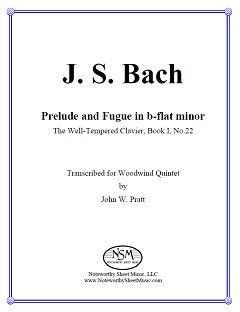 Prelude and Fugue, WTC Book I, No.22, by J.S.Bach
Prelude and Fugue, WTC Book I, No.22, by J.S.Bach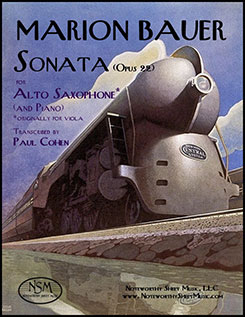
 There is a history of music for viola successfully adapted for saxophone by the composers. Fernande Decruck’s Sonata (1943) for saxophone and piano (or orchestra) was originally written for viola, as was Ross Lee Finney’s Sonata in A Minor from 1937 (viola and piano), adapted for saxophone in the early 1970s. Several works for alto saxophone and orchestra written for the American saxophonist Elise Hall were originally written for viola, including Florent Schmitt’s Legende (1918) and Choral Variee´ (1903) by Vincent D’Indy. Adolph Busch composed his Suite for violin and either viola or alto saxophone in 1926, while in 1923 Darius Milhaud replaced the viola with the saxophone in La Creation du Monde literally positioning the saxophone in the viola chair in the string section. My saxophone adaptation of Bauer’s Sonata combines elements of the clarinet and viola versions, creating a version appropriate for the alto saxophone. This includes changes in range, articulation, phrasing and dynamics to create an idiomatic (though challenging) version for the alto saxophone faithful to the musical intent of the composer.”
There is a history of music for viola successfully adapted for saxophone by the composers. Fernande Decruck’s Sonata (1943) for saxophone and piano (or orchestra) was originally written for viola, as was Ross Lee Finney’s Sonata in A Minor from 1937 (viola and piano), adapted for saxophone in the early 1970s. Several works for alto saxophone and orchestra written for the American saxophonist Elise Hall were originally written for viola, including Florent Schmitt’s Legende (1918) and Choral Variee´ (1903) by Vincent D’Indy. Adolph Busch composed his Suite for violin and either viola or alto saxophone in 1926, while in 1923 Darius Milhaud replaced the viola with the saxophone in La Creation du Monde literally positioning the saxophone in the viola chair in the string section. My saxophone adaptation of Bauer’s Sonata combines elements of the clarinet and viola versions, creating a version appropriate for the alto saxophone. This includes changes in range, articulation, phrasing and dynamics to create an idiomatic (though challenging) version for the alto saxophone faithful to the musical intent of the composer.”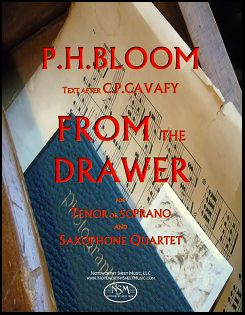
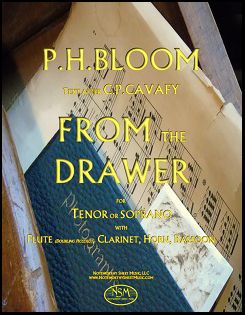 From the Drawer, by Peter H. Bloom
From the Drawer, by Peter H. Bloom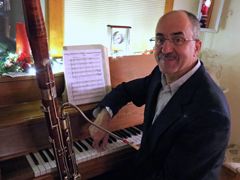 Na Rua dos Meus Ciúmes, Traditional Fado
Na Rua dos Meus Ciúmes, Traditional Fado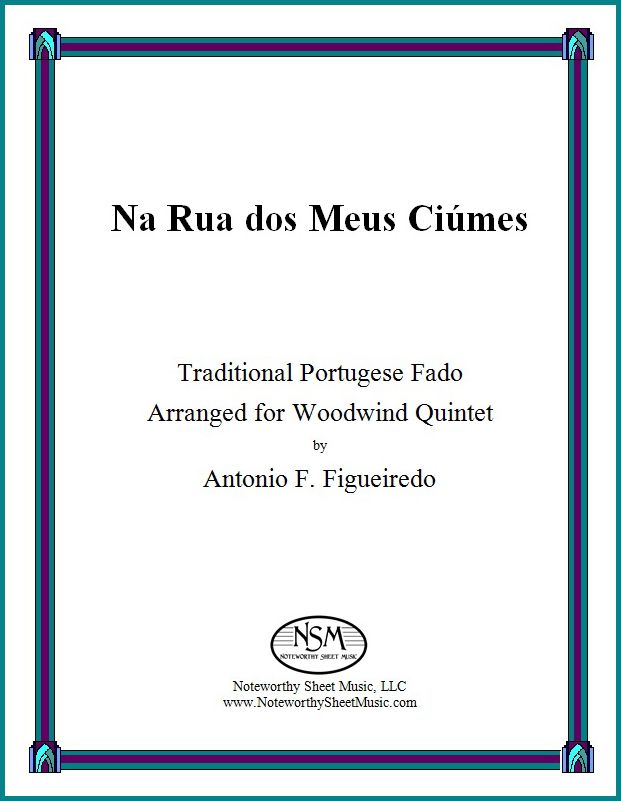
 Danzas Mecánicas, by Peter Van Zandt Lane
Danzas Mecánicas, by Peter Van Zandt Lane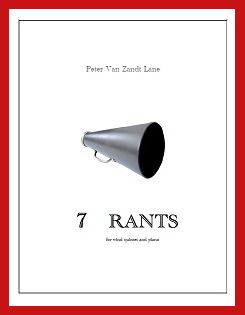 Seven Rants, by Peter Van Zandt Lane
Seven Rants, by Peter Van Zandt Lane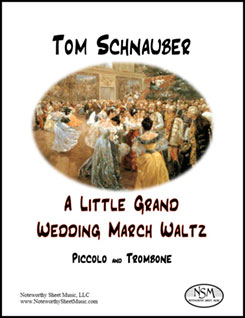 A Little Grand Wedding March Waltz, by Tom Schnauber
A Little Grand Wedding March Waltz, by Tom Schnauber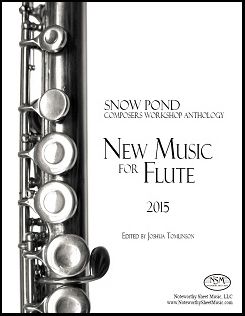 Snow Pond Composers Workshop Anthology New Music for Flute 2015
Snow Pond Composers Workshop Anthology New Music for Flute 2015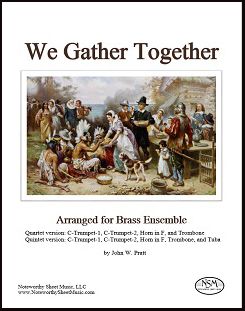 We Gather Together, by Adrianus Valerius
We Gather Together, by Adrianus Valerius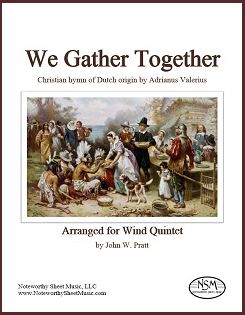 We Gather Together, by Adrianus Valerius
We Gather Together, by Adrianus Valerius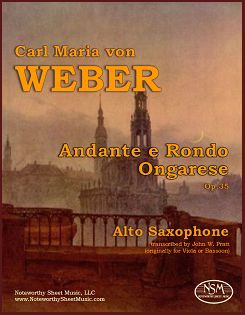 Andante e Rondo Ongarese, Op.35, by Carl Maria von Weber
Andante e Rondo Ongarese, Op.35, by Carl Maria von Weber